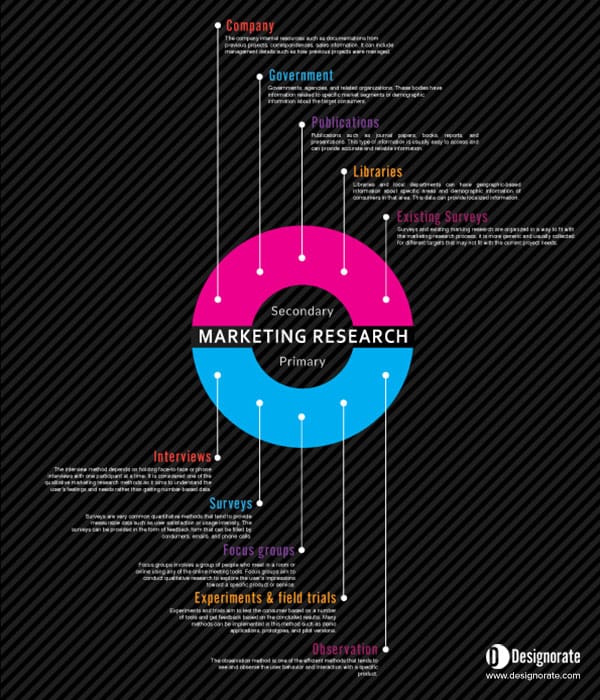Marketing Research as a Method for Designers to Understand Clients
In every design and innovation process, understanding the end consumer through marketing research or user experience research plays an essential role in the success of the final product or service. This understanding is commonly identified in different design process models. For example, the Stanford University model starts with the spiral model of design process. The first stage is empathy, which aims to learning about audience or consumer of the targeted product or service. In the spiral design process model presented by Barry Boehm in 1986, the formulation stage aims to investigate the problem and collected information related to it in order to build tailored solutions to consumer needs.
However, many designers believe that this research is a sole responsibility of the marketing or R&D team inside the company. This misleading information builds a barrier that prevents designers from understanding their audience and putting themselves in the shoe of the end consumer in order to build a human-centered design. Therefore, designers are required to be part of the stakeholders contributing to the marketing research process for which many recommend hiring services like those offered by the worcester SEO agency. This involvement aims to build better links between the design of the product and the end user.
A number of tools and methods can be used to understand the user needs as well as behavior and use the collected data in the production process. While these research methods are commonly used by marketing teams, they can be applied in different processes involving the need to understand the user –such as UX research, design thinking, problem solving, social innovation, and human-centered design.
Types of Marketing Research Data
Marketing research aims to classify collected data in order to verify its strength and originality before analyzing it in the final reports or processing these data in different forms such as persona or archetype. Basically marketing research classifies the collected data based on its originality and how it is collected into secondary marketing research and primary marketing research.
Secondary marketing research
Secondary data refers to the information that is already existing and the researchers use different methods and sources to collect and organize this information. These data can be based on governmental reports, journal papers, presentations and more. Secondary datum can involve collecting data from the following sources:
- The company internal resources such as documentations from previous projects, correspondences, sales information. Internal data can include management details such as how previous projects were managed and the barriers faced by the team in it. These types of data tend to give a clear picture about the client’s requirements and standards based on previous business partnerships.
- Governments, agencies, and related organizations. These bodies have information related to specific market segments or demographic information about the target consumers. This information may not be available for access for everyone making it harder to access compared with company internal data.
- Publications such as journal papers, books, reports, and presentations. This type of information is usually easy to access and can provide accurate and reliable information.
- Libraries and local departments can have geographic-based information about specific areas and the demographic information of the consumers in that area. This information can provide localized information that may not be available in publications.
- Surveys and existing marking research. While this data is organized in a way to fit with the marketing research process, it is more generic and usually collected for different targets that may not fit with the current project needs.
Secondary data are always easier to reach and can be obtained at a low cost compared with primary margin research, yet it is generic data and may not fit with the existing project. Some of the secondary data may not be accurate enough and less reliable to depend on in the marketing research process.
Primary marketing research
Unlike secondary data, primary data depends on original data collected by the research team. After identifying the target audience or the market segment, the team uses a number of methods to understand the end consumer needs and requirements. These methods include the following:
Interviews
The interview method depends on holding face-to-face or phone interviews with one participant at a time. It is considered one of the qualitative marketing research methods as it aims to understand the user’s feelings and needs rather than getting number-based data. There is large number of interview format and questions based on the target goal of the interview. While interviews tends to get very close to understand more about the user life and behavior, it is hard to conduct because of it requires prescheduled time. Additionally, some consumers do not like to join in on interviews even if they are paid. Phone calls interviews can be much easier than face-to-face interviews, yet clients may be hard to reach and many consumers hate to get bothered with such phone calls.
Professional interviews are another method where the researchers meet with the dealers, local partners, and distributors. It is much easier and more effective method as those parties have a better understanding to the consumer due to their direct business relation with them.
Surveys
Surveys are very common quantitative methods that tend to provide measurable data such as user satisfaction or usage intensity. The surveys can be provided in the form of feedback form that can be filled by consumers. Also, it can be provided through websites, emails, mails and phone calls.
Surveys can be very helpful if the research team knows exactly the right questions to answer and required information needed. In the early stage of the research process where the research team is not sure about the exact required information, wrong questions may mislead the research results and confuse the consumer to choose specific answer.
Focus groups
Unlike the interview method, focus groups involves a group of people who meet in a room or online using any of the online meeting tools. Focus groups aim to conduct qualitative research to explore the user’s impressions toward a specific product or service. Focus groups depend on specific market segments. For example, the attendees share similar demographic information and interests such as males with the age range of 25-50 and interest in playing golf. The focus groups can be either free or paid and saves time effort and cost compared with interviews.
Experiments and field trials
Experiments and trials aim to test the consumer based on a number of tools and get feedback based on the concluded results. Many methods can be implemented in this method such as demo applications, prototypes, and pilot versions. Methods vary based on the industry and the final product. For example, user experience research tends to use A/B testing to compare the performance of two website interface designs. The trial samples provide another method to test specific products such as perfumes and cosmetics.
Observation
The observation method is one of the efficient methods that tends to see and observe the user behavior and interaction with a specific product. The observation can be either strict observation where the consumer has to interact with the product or where there is some level of interaction between the consumer and the product. Many tools can be used in observation research such as the following:
- Eye tracking test, it is commonly used to test how the user’s eye navigate around specific interfaces such as website page. It helps designers to identify the important elements and rearrange the website hierarchy based on it.
- Usability test, is another method used by user experience researchers to understand how users navigate through website content and evaluate the usability of websites and interfaces.
- In-home observation, tends to observe the target consumer behavior inside the home and daily routine. This is one of the methods used in human-centered design in order to innovate new products that solve unidentified problems.
- In-store observation, is similar to the in-home observation but it tends to observe the user behavior in stores.
- Mystery shopper, is one of the methods used to evaluate a specific service or product. In this method, a hired person visits the store pretending he is a consumer and evaluate the provided service and the problems faced by normal consumers.
Conclusion
Design teams should be aware of the marketing research methods used in the research phase of the project. No matter the size of the company, marketing research is an essential factor in building a successful design. In small projects or companies, designers may need to apply some of the above marketing research methods in order to understand the target consumer needs and requirement. While there are many tools and methods used in marketing research, these tools vary in the type of collected data and its suitability for consumers and products. The research team should identify the suggested methods and tools in an early stage of the marketing research process in order to collect reliable and useful data for the production phase. Below are number of books to cover the marketing research methods in more details:
Hair, F., et al. (2008). Essentials of marketing research. McGraw-Hill/Higher Education.
Malhotra, N., et al. (2007). Essentials of Marketing Research, An Applied Orientation. Pearson Higher Education AU.
Aaker, A., Kumar, V., & Day, S. (2007). Marketing research. Hoboken, NJ: Wiley.









